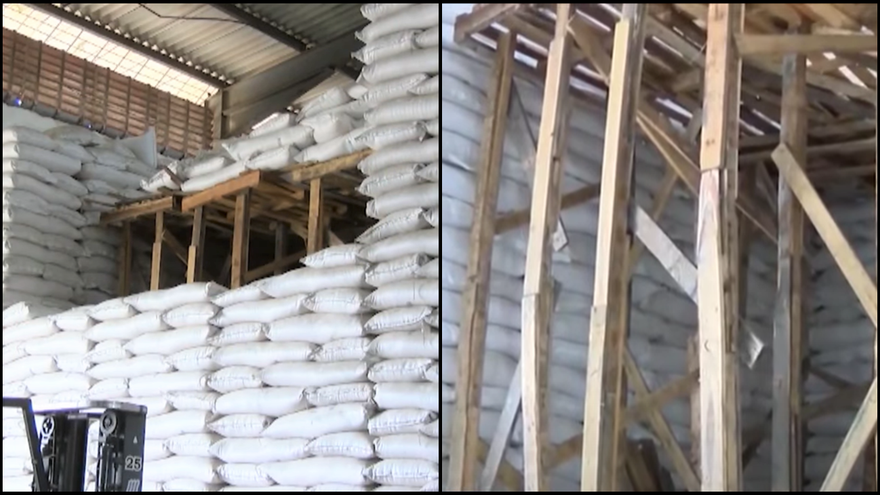
![]() 14ymedio, Havana, 17 November 2020 — The history of thefts from the Cuban state sector has milestones that seem insurmountable. Adulteration of figures, disguising merchandise and even ingenious garments with internal pockets to transport products. This November, the Potemkin warehouse was added to the list , stacks of rice sacks that were only a facade with a large empty space in the center.
14ymedio, Havana, 17 November 2020 — The history of thefts from the Cuban state sector has milestones that seem insurmountable. Adulteration of figures, disguising merchandise and even ingenious garments with internal pockets to transport products. This November, the Potemkin warehouse was added to the list , stacks of rice sacks that were only a facade with a large empty space in the center.
The peculiar incident occurred in Basic Unit 315 of El Cotorro in Havana, according to a report by the National Television Newscast. At the beginning of the report, nothing seemed to differentiate this theft from many others that the official media have denounced in recent weeks, if it were not for the ingenious way in which the perpetrators hid the embezzlement.
The thieves, workers in the state warehouse, erected wooden structures in the center of the piles to occupy the space of the sacks they stole. The shoring allowed the blocks to appear complete during routine inspections, although they were hollow inside. It took a timely count of the merchandise to discover the trick.
At the beginning the authorities calculated that the missing grain totaled 33.5 tons, an amount that represents, according to Manuel Andreu Hernández, director of Defense, Security and Protection, “the quota of 10,550 consumers, with an economic effect on the country’s economy of 14,736 dollars.” However, after a more exhaustive count it was determined that a total of 208 tons were missing.
“The causes and conditions that we see in this type of event are lack of administrative controls and the lack of supervision of the people in charge of carrying out this type of task,” an agent from the Ministry of the Interior explained to the TV camera, while also noting that the product it was intended for the “basic food basket” Cubans can buy cheaply through the ration system, and was imported from Uruguay.
The agent added that this type of event occurs due to the management of “internal control and violations of the procedures established for the commercialization, storage and transportation of products.”
To make up for the losses of the rice, according to official television reports, “the State reallocated part of its budget intended for other products for the purchase of rice.”
The report stated that it is not the first time that “people with certain responsibilities in the protection of the resources destined for the basic food basket have been involved in the diversion of products.”
Andreu Hernández said that the inspection process for the rest of the products stored in the El Cotorro facilities continues.
For their part, the police reported that the investigations have not concluded and are intended to “include in the criminal process other perpetrators who make up the criminal chain, although regardless of whether other perpetrators are found, the damage has already been done.”
Rice, an absolute essential on Cuban tables, is one of the many products that have disappeared due to the shortages and lack of supplies facing the Island in recent months. It has become seven to eight times more expensive since the pandemic began, and almost all of the rice traded on illegal networks is diverted from state-owned companies.
The replacement product from Uruguay is highly appreciated by Cuban consumers, who consider it to be of better quality than the rice donated by Vietnam which is sold in the rationed market. The grain is more complete, there are fewer stones in each bag, and the grains do not stick together, which is more to the traditional taste, all of which makes the South American rice more popular.
Until the beginning of the year, it could be found at five pesos a pound in commercial establishments that sold unrationed rice; however, it has now risen to unsuspected prices. This newspaper reported in May a record price of 45 Cuban pesos* per pound or 90 CUC* for 50 pounds, which has dropped to 20 or 25 pesos in recent weeks.
*Translator’s note: Cuba operates with two Cuban currencies, the Cuban peso and the Cuban convertible peso, and with foreign hard currencies, including the dollar, the euro and others. Currently in flux, the exchange rates are changing very rapidly. At the beginning of this year, 45 Cuban pesos would have been the equivalent of just under $2 US, and 90 Cuban convertible pesos would have been about $90 US. As a point of comparison, government salaries in Cuba generally average the equivalent of about $30 US a month, or, in this example, enough to buy about 15 pounds of unrationed rice a month, and nothing else. The monthly quota of rice each Cuban gets from the rationed market is much cheaper.
________________
COLLABORATE WITH OUR WORK: The 14ymedio team is committed to practicing serious journalism that reflects Cuba’s reality in all its depth. Thank you for joining us on this long journey. We invite you to continue supporting us by becoming a member of 14ymedio now. Together we can continue transforming journalism in Cuba.
